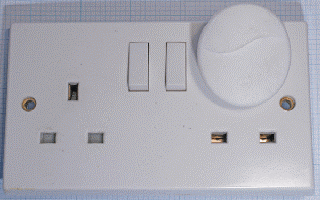For many new and expecting parents, a plug socket cover is a no brainer when baby proofing your home. They’re seen everywhere, including in GP waiting rooms and hospitals across the country, so they must be a safety essential, right? Well, no. Plug socket covers in British sockets may actually be causing more danger than they are solving.
What Is a Plug Socket Cover?
Plug socket covers are small plastic discs that have the 3 prongs of a plug on the back. They are designed to be plugged into a wall socket, supposedly to prevent objects or small fingers from being inserted into the socket.
Dangers of Using Socket Covers?
British plug sockets that conform to BS 1363 standard (which was originally introduced in 1947) have been specifically designed to keep children safe. Babies fingers are not small enough to fit inside the socket far enough to touch live parts, but even if they could, there are insulated shutters inside the holes to stop this.
Sockets have been made to only fit plugs that also have strict requirements. Nothing that doesn’t fit these requirements should ever be plugged into a socket – and plug socket covers do not conform.
The BS 1363 standard actually specifically refers to the fact that plug socket covers are not required: “Socket-outlets conforming to this standard are shuttered and therefore do not require the use of additional means to shield the current-carrying contacts when no plug is present in the socket-outlet.”
Plug Socket Covers: They Create the Danger They Are Trying to Solve
The shutter feature of British sockets means that the insulated shutters covering the live parts of the plug remain closed until something is inserted into the top pin hole.
A curious child could easily insert a plug socket cover into the plug upside down, which will then be held in place with the shutters open. This leaves them with both hands free to insert an object into the now exposed live sections of the plug.
Plug socket covers make it easy to defeat your socket’s in-built safety features.

Fire Hazard
If all of the above isn’t bad enough, plug socket covers are also a fire hazard.
A plug socket cover will look the same as a 13A plug, but plugs must conform to very specific size requirements that plug socket covers simply don’t. Putting the wrong size and shape into your plug socket can cause a number of problems including damage to the shutters, overheating, or fires.
Socket Cover Alternative
Many parents consider using socket covers to protect children, but standard plug-in socket covers can actually pose more danger than they prevent as shown above. Poorly designed covers may bypass built-in safety mechanisms, making sockets more accessible rather than safer. If your looking for more protection than a standard socket can provide try looking at socket cover alternatives such as key operated sockets.
Still unsure what socket is best for you and your home? View all our plug sockets available here!
Key Operated Sockets
An alternative like a key operated socket cover offers a far more secure solution. These covers lock the socket entirely, preventing any access without a key ideal for environments needing stricter safety, like schools or care homes. They reduce the risk of tampering, ensure compliance with safety standards, and provide peace of mind that the socket is genuinely inaccessible when not in use.


 GU10 LED Bulbs
GU10 LED Bulbs
 MR16 LED Bulbs
MR16 LED Bulbs
 GU4 LED Bulbs
GU4 LED Bulbs
 AR111 LED Bulbs
AR111 LED Bulbs
 GX53 LED Bulbs
GX53 LED Bulbs
 G4 LED Bulbs
G4 LED Bulbs
 G9 LED Bulbs
G9 LED Bulbs
 B22 LED Bulbs
B22 LED Bulbs
 B15 LED Bulbs
B15 LED Bulbs
 E27 LED Bulbs
E27 LED Bulbs
 E14 LED Bulbs
E14 LED Bulbs
 PL LED Bulbs
PL LED Bulbs
 R7 LEDs
R7 LEDs
 LED Capsule Bulbs
LED Capsule Bulbs
 Golf Ball LED Bulbs
Golf Ball LED Bulbs
 LED Spotlights
LED Spotlights
 LED PAR Reflectors
LED PAR Reflectors
 GLS LED Bulbs
GLS LED Bulbs
 Candle LED Bulbs
Candle LED Bulbs
 LED Under Cabinet Lighting
LED Under Cabinet Lighting
 LED Tubes
LED Tubes
 LED Battens
LED Battens
 Pygmy LED Bulbs
Pygmy LED Bulbs
 LED Globe Bulbs
LED Globe Bulbs
 Tubular LED Bulbs
Tubular LED Bulbs
 LED Floodlights
LED Floodlights
 Highbay Lights
Highbay Lights
 High Bay LED Bulbs
High Bay LED Bulbs
 LED Bulkheads
LED Bulkheads

 T8 LED Tubes
T8 LED Tubes
 Emergency Lighting
Emergency Lighting
 Site Lighting
Site Lighting
 Integrated LED Downlights
Integrated LED Downlights
 Non-Integrated Downlights
Non-Integrated Downlights
 Non Integrated Luminaires
Non Integrated Luminaires
 LED Wall Lights
LED Wall Lights
 LED Walkover Lights
LED Walkover Lights
 LED Garden Lights
LED Garden Lights
 Home Security Cameras
Home Security Cameras
 Home Security CCTV
Home Security CCTV
 Home Security Alarms
Home Security Alarms
 Doorbells
Doorbells
 Cabling & Accessories
Cabling & Accessories

 Sockets
Sockets
 Dimmer Switches
Dimmer Switches
 Light Switches
Light Switches
 Time Controllers
Time Controllers
 Downlight Accessories & Bezels
Downlight Accessories & Bezels
 LED Drivers
LED Drivers
 600 x 600 LED Panels
600 x 600 LED Panels
 1200 x 600 LED Panels
1200 x 600 LED Panels
 Backlit Panel Lights
Backlit Panel Lights
 Mode
Mode

